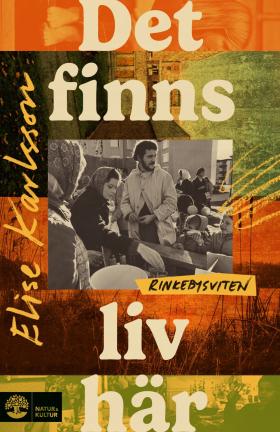
Det finns liv här
(There Is Life Here)
by Elise Karlsson
reviewed by Catherine Venner
Det finns liv här (There Is Life Here) is the first book in Elise Karlsson’s ‘Rinkeby series’ and focusses on the settlement of the same name on the outskirts of Stockholm as well as its residents from 1971 to 1979. They were the first to live in the new housing project, which included initiatives for affordable housing. As a result, many among the area’s population have an immigration background, which looms large throughout the novel while it recounts the hopes, dreams, fears and realities of several fictional residents.
Joseph from Kenya has been well educated and has travelled, but when he falls in love and marries Ann-Sofie, he ends up working as gardener in a church yard as he is unable to find better employment. He is devoted to his young son although he worries about how others look at his mixed-race child. His friendship with Dexter, an American musician, helps him cope with the difficulties of being black in 1970s Sweden. His wife works for one of the socialist parties and their friends are also politicised and left-leaning.
Valentina is a researcher at the university and a political emigrant from Chile, who finds herself living in Rinkeby with her son, while the fate of her husband is unknown. She bumps into Kai at a party and they become a couple. Kai has spent her life in various foster families and is subconsciously looking for a family of her own, in particularly because she had to give her own child up for adoption. She believes she has found this family with Valentina, until her husband Enzo escapes from Chile and plays a large role in the family’s life again. Kai feels threatened by Enzo and also becomes curious about her own sexuality, visiting some of the lesbian and gay nightspots in the city. Valentina is friends with Joseph’s wife through their involvement with the socialist and feminist movement.
Yeliz moves to Rinkeby with her Turkish family in 1971. As the oldest child, she is expected to take care of her brothers. One day while in the park with them she meets Roseanna and they realise they share a similar taste in reading magazines. They strike up a friendship, although their lives are very different, with Yeliz being with her family and under her father’s control most of the time, while Roseanna lives with her single mother, who works evenings in a restaurant, leaving Roseanna alone. When a teacher tells Yeliz’s parents that she may be clever enough to study one day, her parents want her to read more so that she does not have much time for Roseanna. Meanwhile Roseanna’s mother remarries and has another child, who is clearly the favourite. Although both Roseanna and Yeliz have the possibility of going to school together to prepare for university entrance exams, Roseanna decides she would rather work in a shop and soon after moves from her mother’s flat to her boyfriend. Before Yeliz is able to finish school, the family moves back to Turkey, but it becomes clear that her father is reluctant to move back and stays in Rinkeby to ‘do business’.
Throughout the decade, we dip into vignettes of the lives of these characters in and around Rinkeby. They portray seemingly small details which say so much about society in Sweden in the 1970s, yet these stories are also very personal, allowing us as readers to feel very close to the main protagonists and their struggles. The characters occasionally feature in each other’s stories, interacting, sometimes as friends and lovers or sometimes simply seeing each other on the bus and knowing that they come from the same area. Joseph, Valentina and Yeliz also feel a yearning for their homeland as they struggle to find a place in Swedish society, while Kai and Roseanna, who grew up in difficult situations try to create a family around themselves with varying degrees of success.
Det finns liv här is a thought-provoking read that on the face of it appears to chronicle one of Sweden’s most notorious suburbs, but goes much further under the skin. Elise Karlsson has created memorable characters whose fates preoccupy the thoughts of the reader long after finishing the novel and who we hope to meet again in the next book in the Rinkeby series.

Det finns liv här
Natur & Kultur, 2023, 273 pages.
Foreign rights: the author.
Elise Karlsson is an author and publisher. Her previous novel Linjen (The Line) was reviewed by Eric Dickens in SBR 2017:2.
